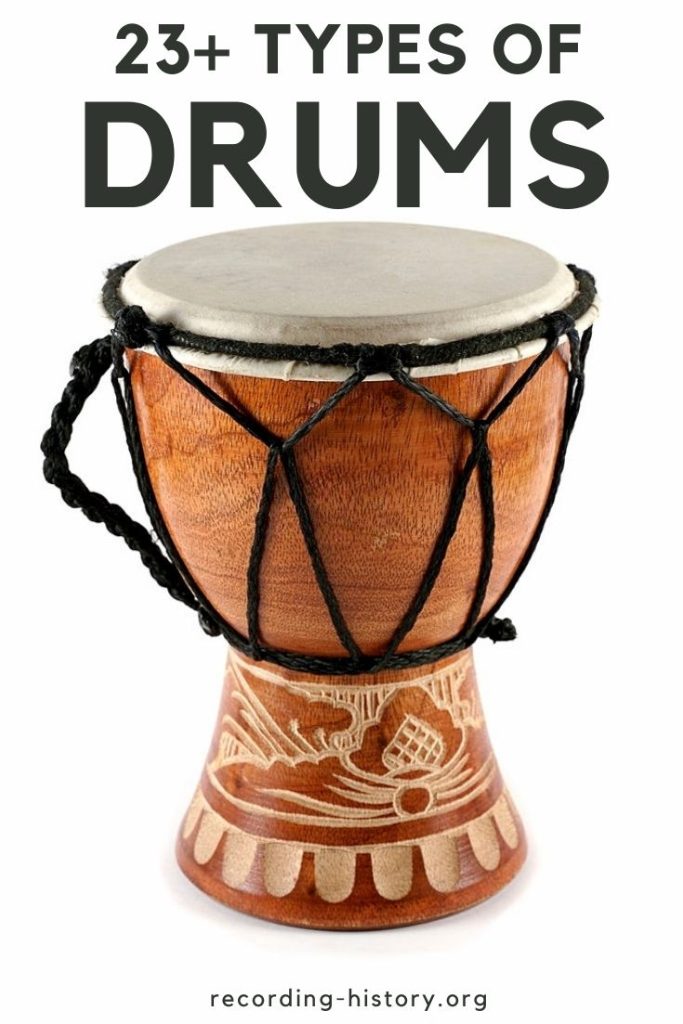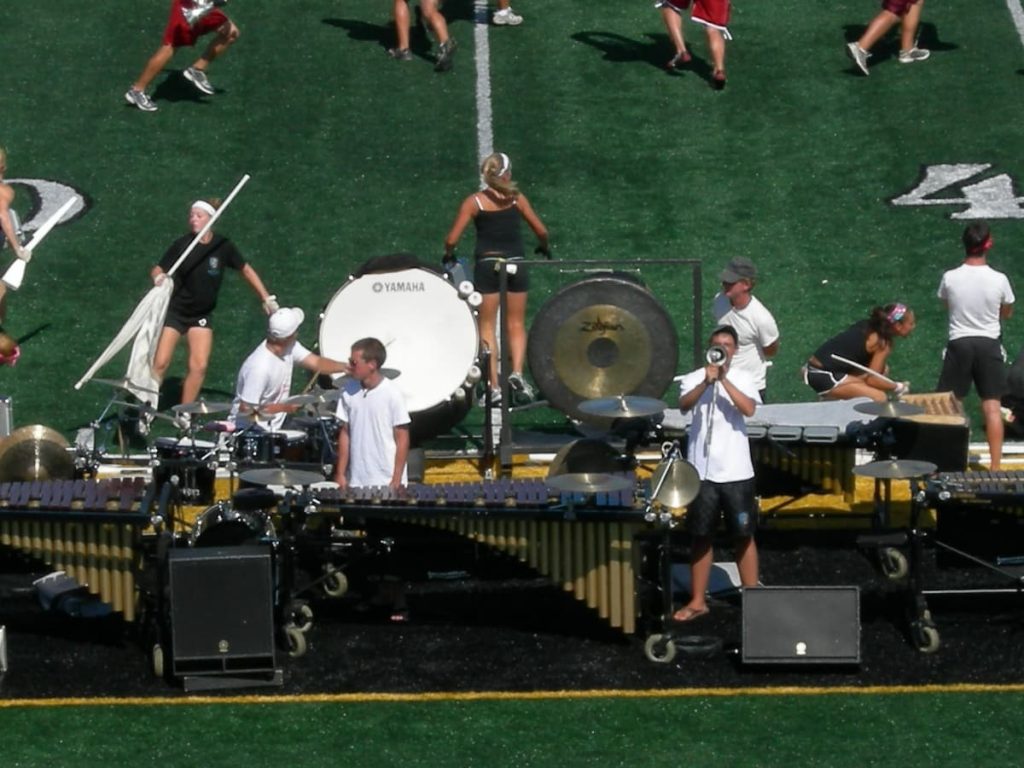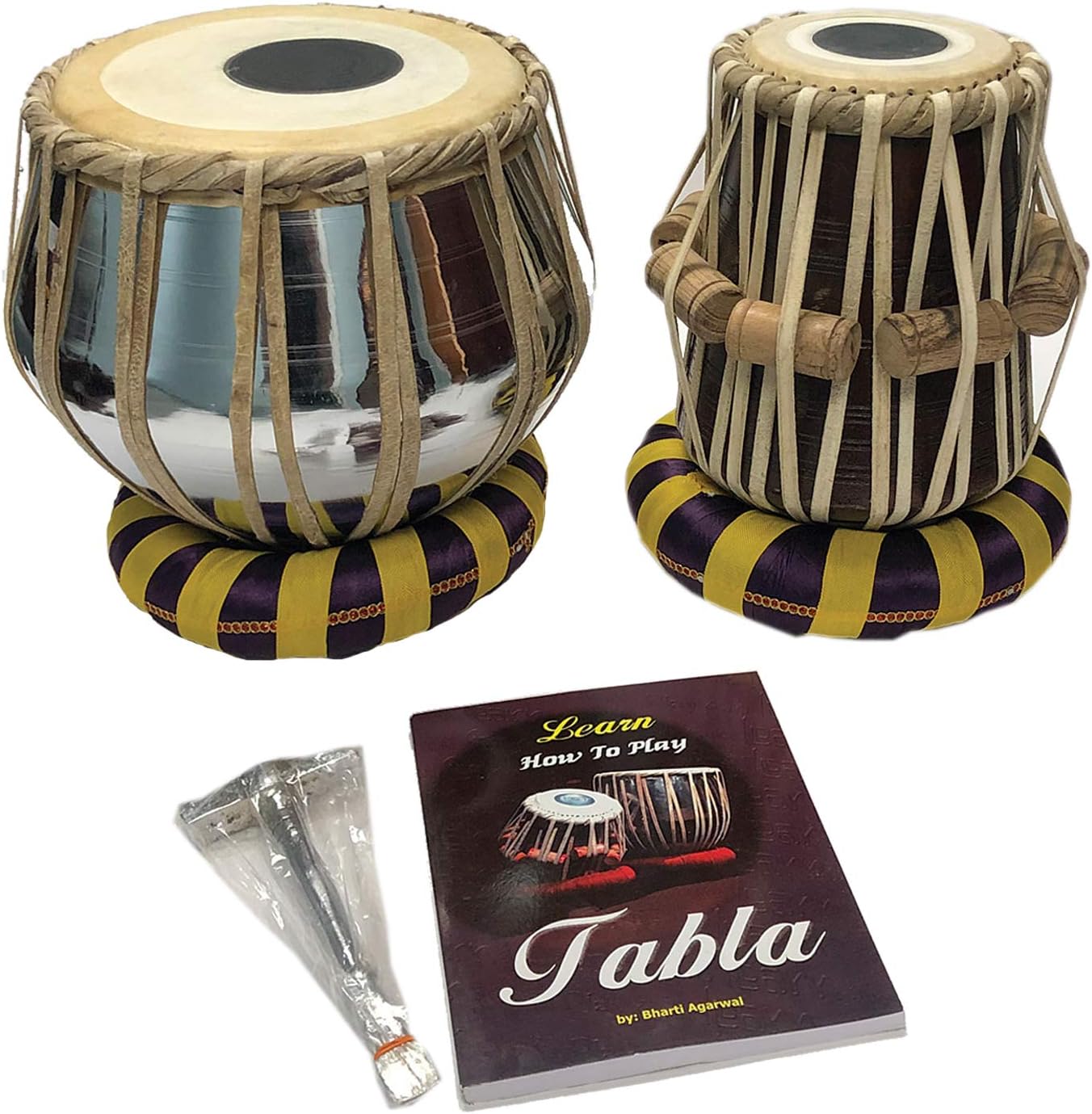20+ Types Of Drums With Pictures
When you think about the oldest musical instrument, think of drums. Drums have been around since anyone can remember. It’s believed that our prehistoric ancestors may have used them many thousand years ago.
Drums come in many different forms. The modern one that you might be familiar with is the new invention. Drums have played a big role in societal life. Many cultures embrace the use of drums in their religious ceremonies and celebrations.

What are Drums?
Drums are percussion instruments that make a sound when you strike their head. They’re a type of membranophone thanks to the stretched membrane attached to their frame. Below are some of the types of drums you’ve likely interacted with.
Related: Types Of Saxophones | Types Of Trumpets | Types Of Flutes
Types of Drums in Classical Music
1. Bass Drum

Bass drums are the largest drums you can come across. They’re the lowest-pitched drums and come in different sizes that enable the melody to run along the line. Bass drums are played with a mallet. They’re left standing up while playing. They’re supported with a stand or even suspended on a frame. Bass drums have very little dampening, enabling them to produce a deep rumble with a long sustain.
2. Tenor Drum

Tenor drums come in various configurations. The most common ones you can lay your hand on consist of 4 to 6 types of drums. They’re also called quads, squints, or quints. But this depends on the number of drums they have. To improve the stability of the sound, all individual drums are put together to enable the same.
Tenor drums have a higher-pitched voice, and you can play them with a pair of drumsticks and mallets. They also have tiny and tightly tuned accent drums in addition to the main drums. These drums have a bright and clean tone.
3. Bodhran Drum

Bodhran is an Irish or Celtic drum made from wood with a goatskin drumhead. But in modern days, you can find bodhrans in plastic shells and artificial skins, thanks to companies who have embraced modernity. Among the amazing features that the bodhran has include skin on one side; its shell is usually between 12 and 24 inches wide and 4 and 8 inches deep.
With just a single skin, you can control the pitch by moving your hand inside the bodhran to control the pitch. You can also use your hand or beaters to play it. The type of beaters that are used to play it is called beaters. You can turn the drum using a crossbar and hex key to adjust the skin tension of the drum. You can also get bodhrans that are untenable.
4. Timpani Drum

Timpani drums are the most popular types of drums in orchestral music. They’re the weighty types of drums with a drum head that is tuned using a pedal. You have to be skillful to play timpani since it’s a difficult job in orchestral music. The timpani are played by a timpanist.
In an orchestral setup, a timpanist is paid higher than other musicians due to the high demand for skills and the heavy nature of this instrument. Therefore, if you see a timpanist playing timpani in an orchestra, don’t think that they’re just banging the drum. They’re doing much more than that. This is because you need to have a lot of experience to tune and play timpani.
You also need to have a lot of guts to perform live on stage with this heavy instrument. On the same note, there is no complete orchestral percussion without timpani. On performance, you can strike it using a mallet a few inches away from the edge to enable it to produce around, resonant, and full sound.
Types of Drums in a Marching Band
Without drums in a marching band, there can be no organization. Drums provide the tenth and tempo that helps in coordinating the whole marching. Drums in a marching band vary in shape, size, and function. A musician has to mount them on themselves for marching. Thus ensuring that there is a tone and prevents any accidents that can be caused if the instrument drops.
Most of the marching band consists of percussion and brass instruments. Here are some of the commonly used drums in the marching band:
5. Marching Snare Drums

You can confuse these drums with a drum kit if you’re not careful. They are very similar to the drum kit, though they’re different drums. It has a deeper skin than a standard version. The skin of the marching snare is made up of tough Kevlar material, which proves to be tougher than any other synthetic skins.
With the extra strong material, the marching snare can withstand high tensions, providing a loud sound. The robust material also allows it to provide a bullet-like, piercing hit. When it comes to playability, you only play a single snare at a time, using two drum sticks to perform drum rolls and solo.
6. Multi-Tenor Drum

Multi tenor drums come in different pitches and sizes. They also come in several configurations, which are four to six. They’re played using sticks or mallets. Multi-tenor drums are highly-pitched melodic voices of the battery. They’re available in small, tightly tuned accent drums which are called spocks. Their tone is very bright and clean.
7. Front Ensemble Drum

The front ensemble is a stationary setup that has various percussion instruments. These instruments include bass drums, cymbals, drum sets, frame drums to the marimba, auxiliary instruments, and woodblock. Cymbals are very massive, hence allowing you to use multiple techniques to play them.
When you strike these cymbals together, they produce a crashing sound, but they’ll produce a more subtle note if you tap them together. Wooden blocks are from teak and can produce a bright beat when you hit them. The ensemble also includes bells, making chime-like bright tones when you strike them with a hard mallet.
Bells or glockenspiel look similar to the xylophone, but it has a metal plate instead of the wooden ones which are on the xylophone. Another instrument in the front ensemble is the marimba which is similar to the xylophone. The only difference marimba has from xylophone is that it has resonator pipes beneath its keys that can amplify and project more sound. All these percussion instruments form the better part of the front ensemble because they’re too big to be carried around.
Types of Hand Drums
These are the oldest types of drums across the globe. They’re very popular across various ancient cultures globally. Each type of hand drum has its unique features and sound. Their unique tone and cultural significance enable them to be the most powerful tool in the drum family. Just as their name suggests, you can play them using your hands. You can as well use mallets and tippers to strike them.
Other types of hand drums are;
8. Tabla Hand Drums

Tabla is a hand drum of Indian origin and is very common in Indian classical music. Tabla drums come in two drums with tapered cylindrical shells that are covered with animal skin. The two drums include the Dayan, which is the smaller drum with a teak or rosewood shell.
The larger drum is called bayan, which has a brass metal shell. The tabla’s shell is made up of different materials and features different sizes. For this reason, the Dayan produces high notes while the bayan is suitable for deeper hits. Tabla drums are played with fingers and the heel of the hand.
9. Bongos Hand Drums

Bongos are the well-known Afro-Cuban hand drums. They’re tiny in size and are played along with Congos. Bongos have the hardest names to pronounce, not unless you’re bilingual. They comprise two pairs, including the macho drum’s smaller ones, while the larger one is known as the hembra drum.
They have conical or slightly tapered wooden shells. But in modern days, manufacturers are using fiberglass and metal to create bongos, making their tone vary slightly between brands. Drummers use the hands and fingertips to play this type of hand drum. Due to their high energy and the momentum of their hits, you can hear their music in salsa and cha-cha.
10. Congas Hand Drums

Congas are tall Cuban drums that come in two or three groups. These groups include the Quinto, the smaller group, and then the medium group called conga, and Tumba, the large group. Congas drums look like barrels, thanks to their large single-headed look.
Despite gaining their origin from Afro-Cuban music, congas are nowadays very common in Latin music. They’re among the favorite instruments among the percussionists. They’re made of hardwood shells. To play congas, you have to mount them a stand because of their hardwood shell construction.
Congas can be played in five basic strokes. There is an open tone which you can play with four fingers by the edge of your skin. The next one is holding your fingers on the skin to muffle the sound, then the third one you can achieve by striking your full palm. And the next is the tono seco and the toque de punta.
11. Cajon Hand Drums

The next type of hand drum is the Cajon. Cajon is a six-sided, box-shaped drum that dates its origin from Peru. It’s played by slapping the front or the rear faces using hands and fingers. Percussionists can also play it using brushes, mallets, and sticks.
Cajon produces a wide range of sounds, depending on where you strike. Nowadays, the Cajon drum is very common in acoustic music. You sat on it while playing it. This sat-on feature makes it an easily portable and versatile instrument that you can carry along anywhere.
12. Doumbek Drums

Doumbek is the North African drum for religious rhythm. It’s a goblet-shaped drum that originates from Egypt. Most Egyptians use this membranophone drum for both religious rhythms and ritual purposes. It’s also called Darbuka. It’s made of wood or clay with animal skin stretched on top of it using rope, nails, or leather thongs.
There Are two main ways to play Doumbek: you can play it under the arm and rest it on the leg. Doumbek consists of two main types: the Egyptian style that has rounded edges around its head tabla]. And then there is the Turkish style called Darbuka. This African goblet can produce three sounds, and there is the doom which is bass, Tak, which is high pitch. And lastly, Ka.
Types of African Drums
African drums are mainly for cultural and ceremonial events, especially in the ancient African tradition. Instead of being an instrument for entertainment, as is in Western cultures, African drums were a symbol of ceremonies and political events. There’re several types of drums found in Africa. Take a look at some of the African drums below:
13. Djembe African Drum

This is one of the diverse African drums that are available. Djembe is very common in Africa because of its ability to produce different pitches in a wider range. It has a goblet-shaped shell and is made from a single piece of hollowed-out wood, plus a goat hide drum skin.
In ancient days, the trunk of a Lenge tree was known for spiritual and tonal purposes among the Mandinka people. The djembe body is categorized into three: the low bass strokes come from the upper body chamber, while the whole hand hits the middle of the drum. And lastly, the long, thin lower section of the drum increases the volume. When a musician slaps their hand near the drum edge, the drum produces a high-pitched tone, thanks to its goatskin.
14. Talking Drum

These are one of the oldest instruments in West Africa, mainly from the Ghana Empire. They were primarily played by African griots while telling stories and spreading the news. This made it an important source of information as villagers heavily relied on it since they had no time to read and write. To play this essential drum, you wrap your arm around the instrument’s body, then squeeze it intermittently.
When you squeeze the drum, the outer rope connecting the skin moves. This makes the skin warp and produces sounds with different pitches. This drum gets its talking vibe from the pitch variation when you squeeze it.
15. Ngoma Drum

From the look of things, it seems most African drums are all associated with traditional cultures. The Ngoma is also not left behind in representing Africa in the traditional beliefs. This drum originates from Bantu Populations in the continent of Africa, especially Congo. It’s derived from the name Kongo which means drum.
It’s made out of wood, while the cow skin is used to cover its upper part. The natives play Ngoma to signify particular dances, rhythms, songs, and social events. This percussion mainly accompanies traditional dances. It’s also known as Engoma and is largely used in the African Great Lakes region and Southern Africa.
16. Udu African Drum

Udu word means pot or vessel, according to the Nigerian language. Despite being an African percussion, it’s designed differently. You might think it’s not from traditional African. This is because it has an extra circular hole on the side of its body on top of the clay water pots.
It was prevalent in women’s ceremonies because women from the Igbo tribe of Nigeria were the only people responsible for collecting drinking water.
To play Udu, you have to quickly hit the side-hole using the palm of your hand as you use the other hand to close the top hole. As you do this, you will experience a soothing but slightly eerie sound that sounds like an ancestral voice. If you want to get a different pitch, you can play it with little water.
Types of Frame Drums
Last but not least in the types of drums are the frame drums. These types of drums are all over the world. To mention a few, you can find them in countries such as Ireland, Asia, and India. They consist of a minimalistic frame and drum skin, hence the name frame drums. The skin of frame drums was crafted from animal skin to allow musicians to create different sounds depending on where they strike.
Look at some of the types of frame drums below:
17. Pandeiro Drum

These are traditional Brazilian drums that are made using shallow wooden shells and animal hide. They look much like tambourines, with their copper and steel cymbals that are around their outer shell. These musical instruments range from around 8 inches to 12 inches in diameter. They’re mainly used to accompany traditional Capoeira marital dances.
Their low pitch and subtle sound allow them to work well with vocals and other instruments. To play pandeiro, you have to hold the drum with your left hand without touching any cymbals, then alternate between striking the skin with your right-hand thumb and fingers.
18. Tambourine Drums

This is among the oldest instruments from Europe. It has remained popular ever since, thanks to its portability. The first models of this percussion were very small hand drums. The small hand drums were made of one or two layers of animal skin and intestine, stretched across a shallow shell.
In the beginning, their design didn’t include cymbals, contrary to the modern varieties, which use cymbals to enhance rhythm sections of a song—talk of diversity when it comes to tambourines.
19. Bodhran Drums

This is an Irish frame instrument, measuring between 12 to 24c inches in diameter, while their shell measures between 4 to 8 inches deep. Its shell was traditionally made from wood, while the beater surface was made from goatskin. But that is not the case because manufacturers use plastic shells and artificial skins to make it nowadays. It has skin on one side, just like pandeiro, to enable the drummer to control the dynamics of every hit.
You can use both crossbar and hex key to tighten or loosen the skin as you tune it. This gives the drummer an opportunity to play different pitches to match up with their counterparts.
20. Goblet Drums

These are famous drums from the Middle East, African, and Eastern Europe. These hollow-shelled drums are made from clay, metal, and wood. They produce a different sound, depending on where you hit, either in the center or the rim.
If you want to get more power and resonance, then hit the center because the rim produces bright, sharp tones. A drummer needs to hold this instrument under one arm and use fingers and palms to strike the rhythm.
What are the large drums called?
The large drums are the bass drums.
What is the most popular drum?
The most popular drums are the snare drums. Musicians love them because of their independent quality sound.
What is the largest drum in an orchestra?
The bass is the biggest drum in an orchestra. This is because of its lowest sounds, thanks to its large snare drum.
What drums should a beginner buy?
The best drum for a beginner is the Gretsch Catalina Club. It offers outstanding longevity and versatility to the beginner.
Related: Types Of Guitars | Types Of Violins | Types Of Pianos
Conclusion
There you have it! There are many types of drums that you will encounter in both cultural and modern music. If you’re an upcoming musician who hasn’t decided on the kind of drums you want to include in your band, then this article can be resourceful to you. Choose one of the percussion instruments and become a professional drummer.


